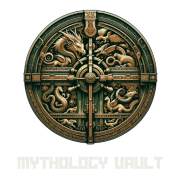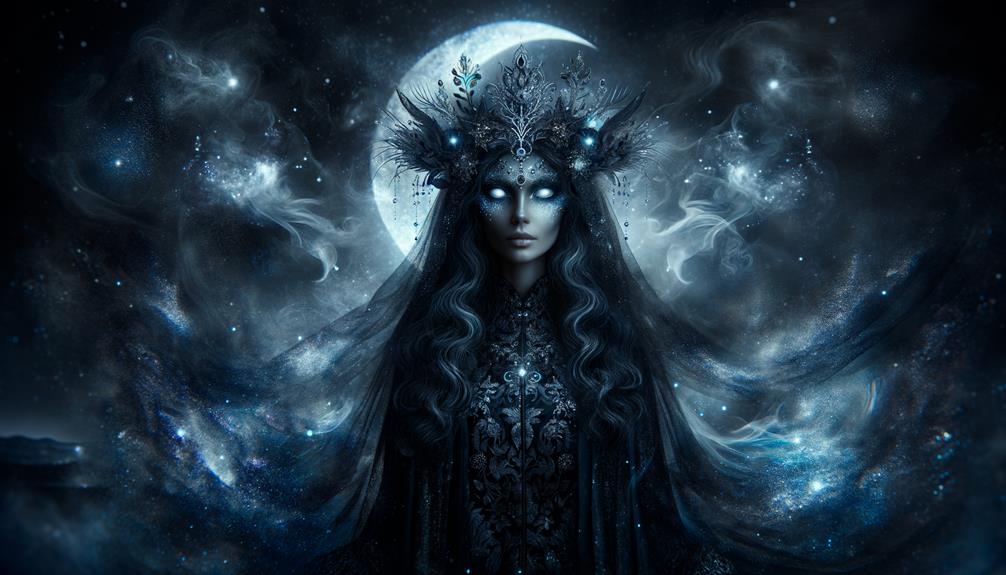Nyx epitomizes the primeval essence of night and darkness, emerging from Chaos itself as the mother to deities like Hypnos and Thanatos. Her symbolic nature governs sleep, dreams, and death – the eternal cycles sustaining life. United with Erebus, Nyx reigns over shadowy realms, embodying both nurturing and formidable archetypes. Ancient texts, like Hesiod's 'Theogony,' illustrate Nyx's pivotal role in balancing light and darkness. Artists commonly depict her draped in black, reflecting her celestial influence. To truly comprehend mythology's intricacies, one must understand Nyx's profound interplay of darkness and illumination.
Origins and Family
Nyx, the embodiment of night and darkness, traces her origins back to the primordial void Chaos, making her one of the most ancient Greek deities. Personifying night itself, her presence pervades ancient Greek cosmology. Birthed from Chaos, she holds a foundational role in mythic narratives.
Nyx's family tree branches extensively, underscoring her status as Chaos's daughter and mother to powerful entities like Hypnos (Sleep), Thanatos (Death), and the Fates governing life's crucial aspects. Her union with Erebus, the living darkness, solidifies ties to the shadowy Greek realms.
As a progenitor, Nyx's influence ripples through her offspring governing life and death's core elements. Her foundational divinity highlights the profundity of her impact across natural and supernatural domains. Nyx's legacy endures, reflecting archetypal creation, darkness, and existence's cyclical nature.
Role in Mythology
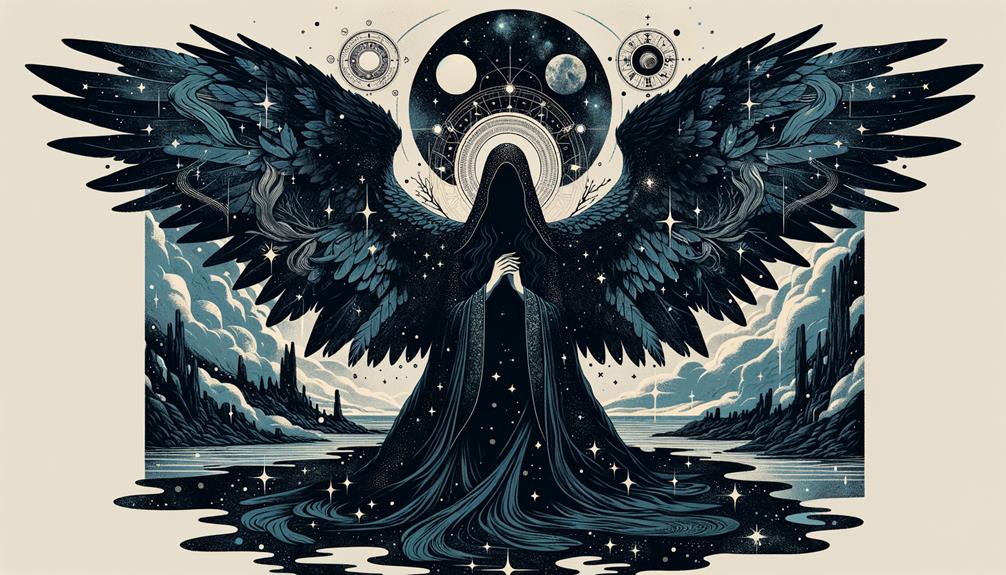
Nyx's legacy extends far beyond her mythological roots. As the night personified and celestial governor, she symbolizes the eternal cycle of existence in Greek mythology. Born from Chaos, Nyx embodied primordial darkness – the source from which everything emerged and will one day return.
Ancient Greek tales showcase Nyx's authority over sleep, death, dreams, and fate, influencing mortals and deities alike. Poets portrayed her nurturing yet formidable nature as the protective mother of Hypnos (Sleep) and Thanatos (Death). Sheltering these potent figures highlighted Nyx's role as guardian of both life and the afterlife.
Her presence in ancient art and literature illustrated her influence over the natural world, maintaining the balance between light and darkness. The cyclical transition from day to night epitomized the continuous ebb and flow of existence – echoing the Greek understanding of life's inherent duality. Through Nyx, we witness an archetypal theme prevalent across mythological traditions: the eternal cycle.
Literary Depictions
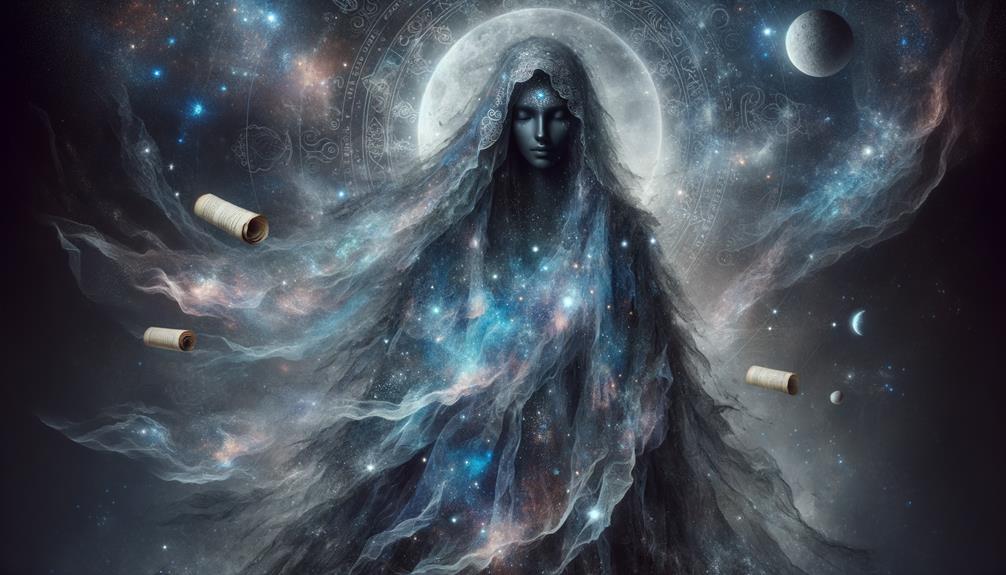
Nyx, the ancient goddess, embodies the primordial essence of night and darkness across texts like Hesiod's Theogony and Virgil's Aeneid. This archetype of the protective, formidable mother resonates through modern retellings, reflecting society's enduring curiosity about the mystical unknown.
Her symbolism as a primal force cuts through eras, a captivating figure that authors continuously revisit. While interpretations evolve, Nyx's influence persists, an elemental cipher for our eternal fascination with what lies beyond the veil of darkness.
Ancient Texts References
Let's dive into the depictions of Nyx, the primordial goddess of night, in ancient Greek and Roman texts. In Hesiod's Theogony, she's portrayed as a powerful deity present at the universe's birth, personifying the night itself – a fundamental cosmic element.
The Iliad by Homer offers a glimpse into Nyx's protective nature when Hypnos, the god of sleep, seeks refuge with her, underscoring her influential divine status.
Virgil's Aeneid casts Nyx as the fierce mother of the Furies, deities connected to vengeance and the Underworld. This link to darkness and retribution cements her formidable nature spanning mortal and immortal realms.
These ancient works collectively establish Nyx as an integral, revered figure in the mythological fabric, her presence woven into the universe's very structure.
Symbolism in Literature
Literary works exploring Nyx delve into the profound and enigmatic qualities of night, highlighting her as a central symbol embodying mystery, protection, and life's cyclical nature. As the Greek Goddess of night, Nyx's portrayal in literature is layered and multifaceted. In Hesiod's Theogony, for instance, her depiction underscores her primordial strength and darkness's inherent potency. Nyx isn't merely a backdrop; she's an active force, revealing other deities and embodying night's essential, often feared, aspects.
Homer's Iliad emphasizes Nyx's formidable and protective qualities. She's more than just darkness – a guardian providing a veil under which life finds refuge and renewal. This duality, both terrifying and nurturing, mirrors night's complex nature.
Literature often investigates these themes, portraying Nyx as a figure influencing dreams and prophecies, reminding us of time's cyclical movement. Poems and texts delving into her mythology reveal the depth of her influence as the primordial night goddess. Through Nyx, literature captures night's eternal dance with light, embodying both ending and new beginning.
Modern Interpretations
Nyx's mysterious essence continues fascinating modern writers, infusing contemporary stories with her profound symbolism and enigmatic charm. Rick Riordan's 'Percy Jackson' series reimagines Nyx as a powerful night goddess, highlighting her timeless appeal and echoing ancient roots.
Contemporary authors often draw inspiration from Nyx's symbolism to explore themes like mystery, magic, and unseen forces. Her character embodies the powerful, enigmatic feminine – reflecting an enduring divine allure. Literature's fascination with Nyx reveals an ongoing engagement with mythology, where her presence transcends time.
As novels and poetry reimagine Nyx, they breathe new life into her ancient spirit. By delving into her profound symbols, modern works offer readers a connection to the past while unraveling the present's complexities – unveiling the goddess's enduring power and mystique.
Artistic Representations
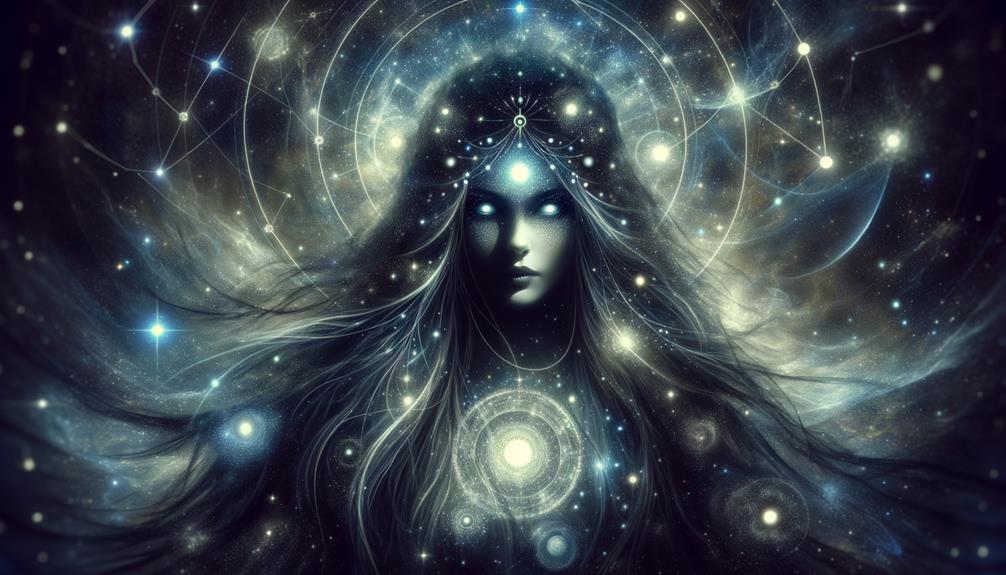
Nyx frequently appears in ancient Greek paintings draped in black robes, representing her reign over the night. Modern artists continue capturing her essence, blending traditional symbols with fresh styles. These works highlight Nyx's archetypal role as the primordial goddess of darkness, showcasing her lasting impact across eras and cultures.
Ancient Greek Paintings
Greek artists expertly captured Nyx's essence as the night goddess through symbolic visuals. Her flowing black robes blended seamlessly with the darkness she ruled, embodying the night itself shrouding her in an aura of mystique and influence. Depicted with wings, Nyx's ability to soar across the night sky overseeing celestial events emphasized her cosmic significance. Imagery portrayed her as a charioteer, guiding horses through starry realms, highlighting her authority over nocturnal phenomena.
These ancient paintings didn't merely present Nyx as a shadowy figure; they wove her into mythological narratives, showcasing her pivotal role in Greek cosmology. Artworks vividly brought to life the archetypal themes surrounding Nyx – mystery, power, and celestial governance.
Modern Artistic Interpretations
Contemporary artists interpret the alluring mystery of Nyx through vivid works evoking her sovereignty over night and primordial forces. In modern art, Nyx emerges as a commanding yet enigmatic figure, cloaked in darkness and ethereal grace. These interpretations underscore her connection to the night, employing shadowy hues and celestial motifs like stars and moons.
Rather than portraying her as a mythological relic, artists infuse Nyx with timeless symbolism and archetypal themes. Her formidable presence juxtaposes delicate nocturnal beauty, inviting viewers to explore the unsettling depths of her dominion. Combining mythology and modernity, these works celebrate Nyx's enduring power, provoking contemplation on the profound truths veiled in darkness.
Symbolism in Art
Artists brilliantly capture the essence of Nyx, the Greek goddess of night, through symbolic elements. Her dark robe directly represents the night's domain and its mysteries, an archetype of the hidden and unknown depths of the human psyche. Wings or a chariot often accompany Nyx, depicting her celestial influence and ability to traverse realms.
Enveloping Nyx is a misty crown, a visual metaphor for her mysterious power to conceal and reveal truths. Through sculptures and paintings, artists pay tribute to Nyx's enduring legacy as the personification of night's profound enigmas. Each portrayal reflects her significance in Greek mythology, showcasing the allure of darkness and the celestial unknown.
Cult and Worship
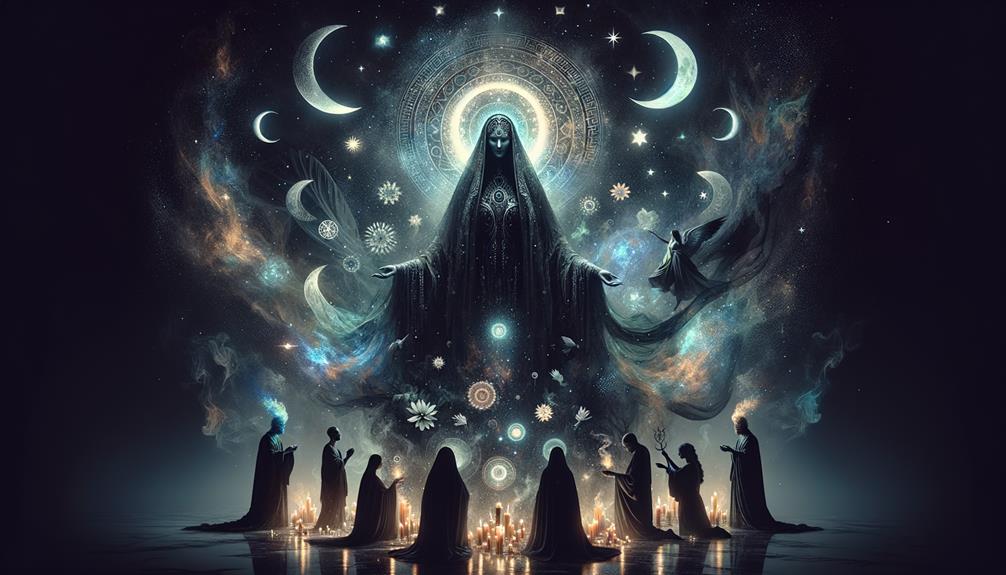
Despite her enigmatic presence, small groups maintained Nyx's worship under the glow of the full moon. As the night goddess, she personified darkness and creation—concepts that resonated profoundly with those seeking her favor. These followers believed offering moonstone, a gem thought to capture the night's essence, would bring tranquility and protection through her blessings.
While not as prominent as other Greek deities, Nyx's role underscored her cosmic significance. Rituals took place in darkness when her power was thought strongest. Her devotees revered her as the primordial force behind creation, acknowledging her in night's natural cycle.
Across cultures, comparable goddesses existed, but Nyx's lunar and dark associations forged her distinct identity. Studying her worship illuminates ancient beliefs about light, darkness, creation, destruction, and the cosmos' eternal rhythms.
Legacy and Influence
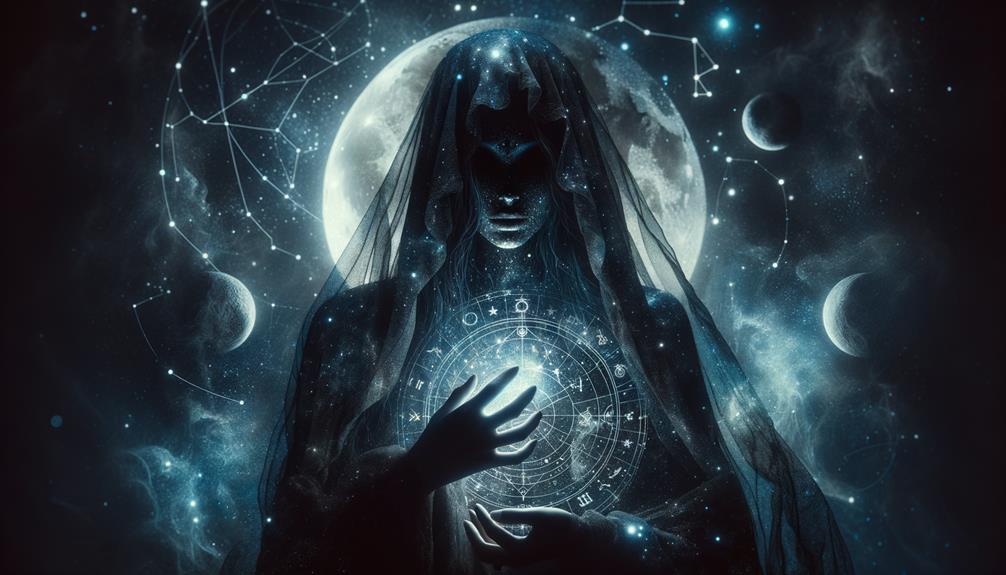
Nyx's enduring impact is evident across art, culture, and scholarly discussions, highlighting her significant role in Greek cosmogony. As a primordial goddess, she personified the fundamental contrast between night and day, influencing celestial events and natural phenomena. Her portrayal in mythology transcends symbolism, reflecting the human experience's darker aspects and the perpetual equilibrium between light and darkness.
Ancient pottery and frescoes depicted Nyx's ethereal form, representing night as both nurturing and formidable. Her cultural significance extended beyond visual representations, permeating literature and rituals where nocturnal ceremonies honored her power. Nyx's offspring in Greek mythology, from Hypnos (Sleep) to Thanatos (Death), further cemented her influence as they embodied essential human experiences and cosmic principles.
Mirroring nocturnal deities in other cultures, Nyx exemplified universal archetypal themes. Her legacy pays tribute to the ancients' reverence for night, acknowledging its mysteries and the primordial goddess who governed it. Through ongoing scholarly exploration, Nyx's profound cultural significance and lasting influence continue to resonate with modern audiences.
Frequently Asked Questions
Who Is the Primordial Goddess of the Night Nyx?
Nyx, the ancient goddess of night, cloaks the cosmos in darkness and mystery. Her domain encompasses slumber's tranquility and dreams' allure – an everlasting interplay of light and shadow.
What Is the Story of Nyx the Goddess of Night?
Nyx's narrative delves into the primal darkness from which existence emerged. Birthed by Chaos itself, she brought forth deities like Hypnos and Thanatos, shaping the cosmic rhythms. Her symbolism evokes the enigmatic veil of night, influencing the ebb and flow of the natural world.
Why Is Zeus Afraid of Nyx?
Zeus feels apprehensive towards Nyx because her primal nature represents the mysteries of darkness, a realm beyond his divine influence. As the archetypal mother of dreams and secrets, she commands an ancient power that even the mighty ruler of gods cannot easily defy.
Was Nyx Good or Evil?
Nyx defies simple categorization as good or evil. Her embodiment of night and darkness serves a vital cosmic role, maintaining the delicate universal balance. Whether ushering in slumber or escorting souls from this realm, her actions reflect an innate, impartial essence at the core of existence itself.
